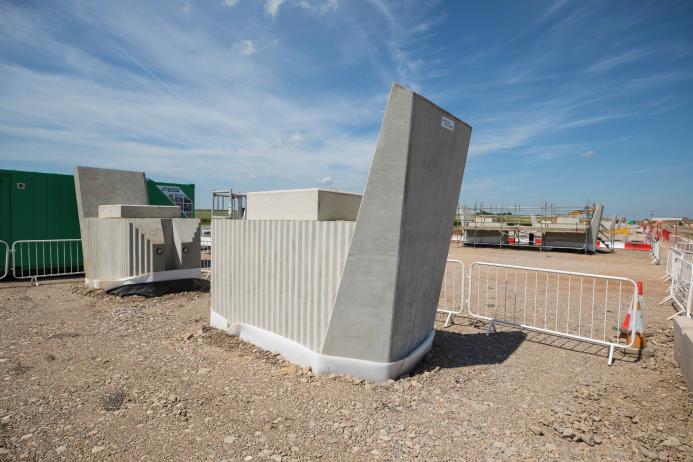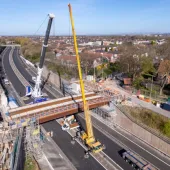Video: First ‘Lego block’ beams lifted for HS2’s Thame Valley Viaduct
HS2 has begun lifting the first of 72 huge beams that will support the deck of the Thame Valley Viaduct – the first of its kind in the UK to have all major elements manufactured off-site.
Engineers at the site near Aylesbury used two massive cranes to lift the beams, 25m-long and weighing 90 tonnes each, into position on top of the viaduct piers, like giant Lego blocks.
Instead of using a more traditional approach, with multiple smaller beams for each span, the design team opted for a simple structural solution with just two larger hollow u-shaped beams per span, which allows for a lighter structure and simpler construction.
The lighter-weight design, inspired by viaducts on the Spanish high-speed rail network, also reduces the amount of carbon-intensive concrete and steel in the structure – cutting its carbon footprint by around a third.
Crossing the flood plain of the River Thame, the 880m long viaduct will carry HS2 services between London and Birmingham – dramatically improving journeys while freeing up space for more freight and local services on the existing network.
Set low into the landscape with a purposefully simple and consistent profile, the underside of the viaduct will be just 3m above the ground, with 36 even spans crossing the river and surrounding floodplains.
The viaduct was designed by HS2 Ltd’s main works contractor, EKFB - a team made up of Eiffage, Kier, Ferrovial Construction and BAM Nuttall - working with specialist on-site construction partner, FC Civils Solutions.
Following the success of the design, a similar approach is also being considered for the nearby Edgcote Viaduct in Northamptonshire.
Traditionally, viaduct beams – even when manufactured off-site - are secured together above each of the piers with a concrete diaphragm which is cast in situ. The larger pre-cast beams that will be used at Thame Valley and Edgcote can be secured directly to one another, removing the need for the diaphragm.
The deck on top of the beams, which will carry the track, will also be made from pre-cast concrete planks. This means that every major element of the structure – the piers, beams, deck planks, and parapets - can be pre-fabricated and slotted together.
As well as cutting embedded carbon by using less concrete and steel, the pre-fabricated approach also requires fewer lorries to deliver material to the site, simplifies construction, cuts waste and reduces disruption for the community during construction. Safety on site is also improved by reducing the amount of work at height.
The 68 giant concrete piers – each weighing 42 tonnes – are also being cast at PACADAR UK’s factory on the Isle of Grain, in Kent. The first 36 piers were lifted into position on top of their foundations since early summer.
Off-site manufacturing also helps spread contract opportunities and supply chain jobs across the UK, with 200 people - including apprentices and graduate engineers from nearby Universities - employed on the Isle of Grain, delivering the viaduct and also making tunnel segments for HS2’s London tunnels.
Today’s construction milestone also coincides with the reopening of the nearby Princes Risborough to Aylesbury line, which had been closed for 10 weeks to allow a bridge to be installed that will carry local trains over the HS2 mainline just south of Aylesbury.











